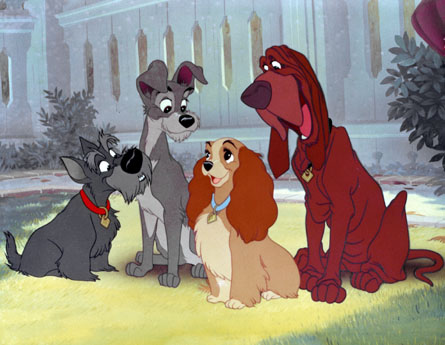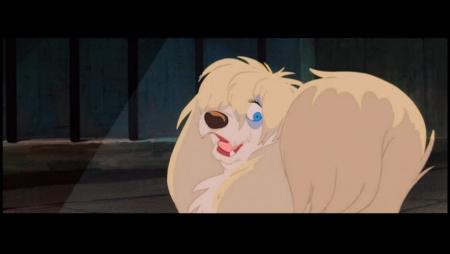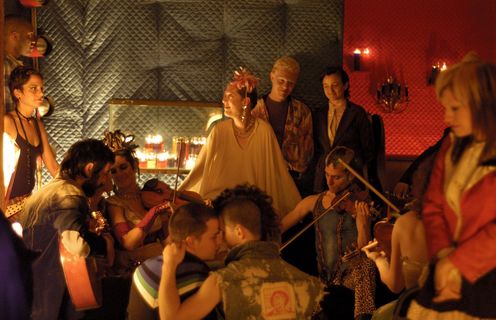Lady and the Tramp
Directed by Clyde Geronimi, Wilfred Jackson, Hamilton Luske
Written by Erdman Penner, Joe Rinaldi, Ralph Wright, Don DaGradi
Starring Barbara Luddy, Larry Roberts, Verna Felton
Whether you’re a Disney nut like me, a film buff, an animation buff, or just interested in 20th-century Americana, you’d do well to read Neal Gabler’s biography of the late Walt Disney, called Walt Disney: The Triumph of the American Imagination. Though it’s an unauthorized work, Gabler had a high amount of access to the official Disney archives, so the book is well-sourced, detailed, and a compelling read. Gabler digs deep into Disney’s childhood, the tough times he had as an animator and businessman before creating Mickey Mouse, one of the truly seminal icons of American history, as well as the difficulties he faced and sometimes created once he became a household name. And yet, despite all of the research that Gabler did, despite all of the anecdotes he describes, he leaves out the fateful day in Walt Disney’s life when a cat killed his father.
What, you didn’t know that this tragic and insane event happened? Well, maybe it wasn’t his father who died, but his mother. Or his sister. Or his second cousin three times removed. Whatever the case, Walt Disney had an issue with cats that manifested itself through the animated shorts, animated movies, and live-action movies in which he was involved. Quite frankly, the anti-cat undercurrent remains present today, more than 45 years after he passed away. You could argue, of course, that two of the many Disney animated features feature cats as the leads: The Aristocats and Oliver and Company. What’s more, the former clearly has the stamp of the older era of Disney animation, even if the man had died by the time the movie came out. I would strongly argue that these are two of the worst Disney animated features to this point in history, though.
That aside, cats get the shaft in Disney films. Pluto was the lovable, trusty pal to Mickey Mouse. Dogs are seen as heroic and helpful in any kind of Disney film, and cats are seen as villainous or are mistreated most of the time, from Cinderella to Pinocchio. The latter film is my favorite traditionally animated movie, but Figaro, Geppetto’s cat, is treated like a slave, being forced to literally open a window for a human in the early going. Like I said, cats get the shaft. And there’s no film where the perceived villainy of our feline friends—yes, I am a cat person, readers—is on display more than in 1955’s Lady and the Tramp. Most people fondly remember this film for the romance between the title characters, a cocker spaniel and a mutt from different walks of life who meet and inexplicably fall for each other. But people also remember the “We Are Siamese” sequence midway through the film, which is one of its low points.
In the scene, Lady faces off against twin Siamese cats. These cats are visiting Lady’s house because their owner, Aunt Sarah, is babysitting for Lady’s owners’ baby. Lady’s owners, Jim Dear and Darling, are on a well-timed vacation, and have left the house in the care of someone who’s not only a cat fanatic (one of those truly cartoonish and garish people who treats their pets like superiors, let alone their equals), but someone who loathes dogs. As such, she has no idea that the mayhem and destruction that occurs downstairs while she’s upstairs watching the baby is because of her lovely Siamese cats, not Lady. This helps lead Lady into being affixed with a muzzle, running away from Aunt Sarah, and getting to know Tramp, the mutt who first warns her that when Jim Dear and Darling have their baby, she’ll be persona non grata within no time.
The fact that Tramp is right within the story doesn’t work, simply because he’s right thanks to the humans in the movie being blithering idiots. Jim Dear and Darling are given a bit more dimension than the dogcatcher, Aunt Sarah, and even Tony and Joe, the two friendly Italian men who run the restaurant where that iconic spaghetti-slurping scene takes place. But because we don’t see their faces for the majority of the film—a calculated and somewhat clever decision by Disney and his animators, to be sure—it makes those characters caricatures more than anything else. Aunt Sarah is a shrill harpy with or without cats, but the cats simply paint her as a more demonic presence at the house.
And, as I mentioned to Gabe on the podcast, those cats are troublesome at best, and racist at worst. Anyone who owns Siamese cats—and, really, anyone with knowledge of various cat breeds—knows that Siamese cats don’t all look like the menacing, conniving duo in Lady and the Tramp. Yes, some Siamese breeds are thin and have wider faces and eyes. But somehow, animating that type of cat, along with the extremely stereotypical Asian-tinged music accompanying their appearance, comes off as boneheaded. Here’s the thing: the animators made a specific choice by not only making the cats evil, but by animating them in a crude, offensive way. You want cats to be the bane of Lady’s existence in a sequence in your movie? Fine. You want them to be Siamese? O…K. You want them to look as stereotypically slant-eyed as any World War II-era propaganda? You’ve lost me as an audience member.
I shouldn’t be focusing on this, you’re saying. You want me to talk more about the sweet scene where Lady and Tramp have their date at Tony’s restaurant, where he nudges the meatball in her direction, where their snouts touch while eating a strand of spaghetti. And not for nothing is that scene built into the Disney iconography: it’s about as untouchable as any scene in animation of any kind, let alone Disney animation. There’s a reason we all remember that scene, scored to “Bella Notte,” years after seeing it as children. It works very well. But it’s one scene in a 75-minute movie, sadly. And I must point out, as I did on the show, that one reason why this moment resonates so much is that the two lead characters aren’t talking. When they talk to each other, the romantic relationship falls apart, having barely any foundation.
Does the romantic relationship work for most viewers? I think so, though I do wonder if favoring dogs or forgetting the dialogue-based interactions the two leads have is part of why everyone thinks of the film so fondly. I don’t mean to box you into having one opinion or the other, by the way; if you listen to the excellent Filmspotting podcast—which, duh, you should—you may have heard Andrew Stanton, director of WALL-E and John Carter, extol Lady and the Tramp’s virtues as his number-two of the Top 5 Traditionally Animated Movies. (Shameless plug: I made a minute-long cameo on this episode, revealing my pick for the best ever. It’s an awesome opportunity, so check it out.) Stanton didn’t focus on the fact that the movie has tons of cute doggies, or on those few iconic moments. He may see depth where I don’t, and I can safely assume he buys the relationship that I reject.
Being fair, it’s not as if the Disney animators don’t try their hardest to bond Lady and Tramp in their long time together—roughly a third of the film is their long meet-cute, as Roger Ebert would put it. But Barbara Luddy and Larry Roberts, the respective voice actors, have no charisma or chemistry with each other; Roberts feels like her brother when they talk to each other. Somehow, his affectionate pet names for her sound like condescending things you call your sister when you want to be a brat. Luddy’s voice sounds too adult for his playfulness, too. There’s just something too detached from their supposed camaraderie for me to relate to. Even if the main characters are dogs, the love is meant to be universal. If you, like me, don’t buy it, then the movie’s in trouble.
The animation in Lady and the Tramp is the true star of the film, especially when you watch it on Blu-ray. Like most every Disney Blu-ray, the transfer here is excellent and there are few more deserving older films. Whatever issues I have with the story, I have none with the look of the film. If anything, the uber-American nature of Walt Disney’s company and personality are too far over-the-top here. I phrased it as such on the podcast, but truly, considering the film as Norman Rockwell paintings come to life is fairly accurate. Steeped in calming, soothing imagery of time past, Lady and the Tramp either makes the case for Disney-brand nostalgia or proves why you hate the man’s work, depending on your view. I understand why some people might choke on this kind of feel-good imagery, but the detail of the animation is enough to distract me from even the more ham-fisted compositions.
The problems I have with Lady and the Tramp boil down to that scene where Lady faces off against the Siamese twins. There’s cleverness in the scene, of course, and a fair bit of wit. The music is memorable, the animation a highlight. But the story, the actual details of what’s transpiring on screen, fails to engage. The people behind the film choose to go down a treacherous road; they’re not forced to delve into stereotypes, but engage in it, and do so throughout the film. By raising questions that do not need to be raised, and cannot be answered in a satisfactory fashion, the filmmakers merely create issues. The story of this movie is sweet and simple enough, but the people telling it couldn’t leave well enough alone.








